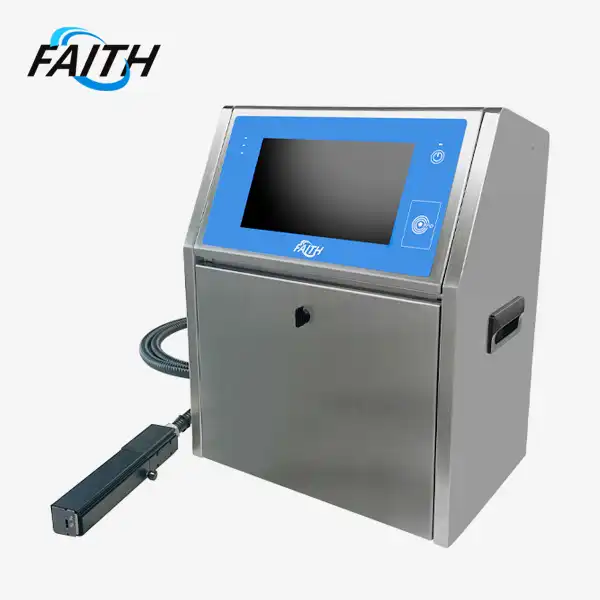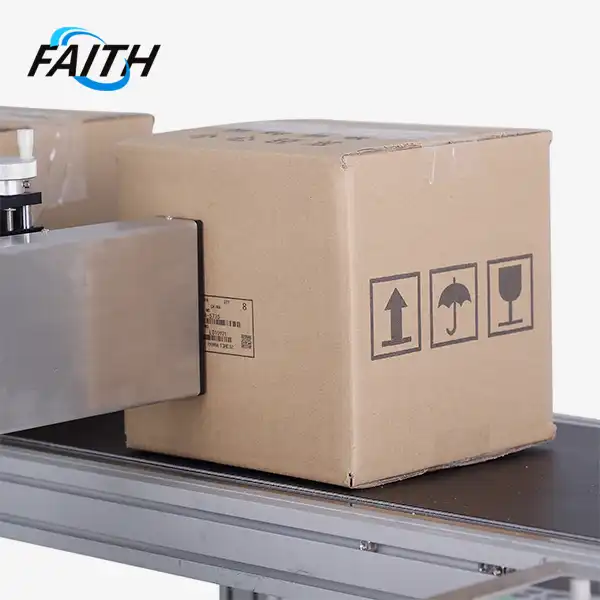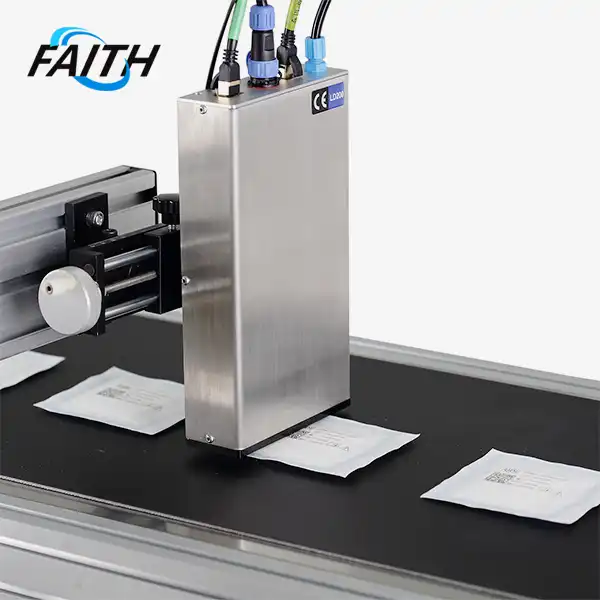2025 Outlook: Demand Trends for CIJ Small Character Printers
As we approach 2025, the demand for CIJ Small Character Industrial Inkjet Printers is poised for significant growth. These versatile printing solutions are becoming increasingly essential across various industries, driven by the need for efficient, high-quality coding and marking on diverse surfaces. The market is expected to witness a surge in demand, particularly for compact, cost-effective models like the FSP001, which offers local consumable procurement, multi-language customization, and adaptability to uneven surfaces. Manufacturers are likely to focus on enhancing printer capabilities, improving sustainability, and integrating advanced technologies to meet evolving industry requirements.
The Evolution of CIJ Technology: Advancing Precision and Versatility
CIJ Small Character Industrial Inkjet Printers have come a long way since their inception. These printers have revolutionized the way industries approach product coding and marking. The technology behind Classic CIJ printers has continuously evolved, offering improved precision, faster printing speeds, and enhanced versatility.
Advancements in Ink Formulations
One of the key areas of development in CIJ technology is ink formulation. Manufacturers are investing heavily in research and development to create inks that adhere better to a wider range of surfaces, dry faster, and offer improved durability. This is particularly crucial for industries that require printing on challenging materials such as plastics, metals, and glass.
The FSP001 model, for instance, exemplifies this trend by offering compatibility with various surfaces, including concave, convex, and curved surfaces. This versatility is achieved through advanced ink formulations that can adapt to different material properties.
Enhanced Printhead Technology
Printhead technology is another area witnessing significant advancements. Modern CIJ printers are equipped with sophisticated printheads that offer higher resolution and more precise droplet placement. This results in sharper, more legible prints, even on small surfaces or at high production speeds.
The ability to print text, dates, logos, QR codes, and barcodes with exceptional clarity is a testament to these advancements. This capability is particularly valuable in industries such as electronics, where component marking needs to be both small and highly accurate.
Integration of Smart Features
As we move towards 2025, CIJ printers are becoming smarter. Integration of IoT (Internet of Things) technology allows for real-time monitoring of printer performance, predictive maintenance, and remote diagnostics. This not only improves operational efficiency but also reduces downtime, a critical factor in high-volume production environments.
Features like multi-language customization, as seen in the FSP001, reflect the growing trend of smart, user-friendly interfaces. This adaptability is crucial for global manufacturers operating across different regions and languages.
Industry-Specific Demand Drivers for CIJ Printers
The demand for CIJ Small Character Industrial Inkjet Printers is not uniform across all sectors. Different industries have unique requirements and challenges that are shaping their adoption of this technology.
Food and Beverage Sector
In the food and beverage industry, traceability and compliance with regulatory standards are paramount. CIJ printers are invaluable for printing batch numbers, expiration dates, and production codes on various packaging materials. The ability of printers like the FSP001 to work effectively on different surfaces, including plastic bottles and metal cans, makes them indispensable in this sector.
As consumers become more health-conscious and demand greater transparency about food origins and ingredients, the need for clear, detailed product marking is increasing. This trend is expected to drive further adoption of advanced CIJ printing solutions in the food and beverage industry.
Pharmaceutical and Healthcare Industries
The pharmaceutical sector faces stringent requirements for product identification and anti-counterfeiting measures. Faith printers play a crucial role in printing batch numbers, expiration dates, and unique identifiers on medication packaging and medical devices.
The demand for CIJ printers in this sector is expected to grow significantly as regulations become more stringent and the need for serialization increases. The ability to print small, high-resolution characters and machine-readable codes is particularly valuable in this context.
Electronics and Automotive Sectors
In the electronics and automotive industries, component traceability is critical for quality control and warranty management. CIJ printers are used to mark individual components with unique identifiers, often on small or irregularly shaped surfaces.
The trend towards miniaturization in electronics and the increasing complexity of automotive components are driving demand for CIJ printers capable of printing on very small surfaces with high precision. The FSP001's suitability for printing on electronic components and cables aligns perfectly with this industry trend.
Emerging Trends Shaping the Future of CIJ Printing
As we look towards 2025, several key trends are emerging that will shape the future of CIJ Small Character Industrial Inkjet Printers.
Sustainability and Eco-Friendly Solutions
Environmental concerns are becoming increasingly important across all industries. In the realm of CIJ printing, this translates to a growing demand for eco-friendly inks and more energy-efficient printers. Manufacturers are developing water-based and low-VOC (Volatile Organic Compound) inks that reduce environmental impact without compromising on print quality or adherence.
The trend towards local procurement of consumables, as seen with the FSP001 model, not only reduces costs but also aligns with sustainability goals by minimizing transportation-related carbon emissions.
Integration with Industry 4.0
The concept of Industry 4.0, or the Fourth Industrial Revolution, is driving significant changes in manufacturing processes. CIJ printers are evolving to become an integral part of this connected, data-driven manufacturing environment.
Future CIJ printers are expected to offer seamless integration with factory management systems, enabling real-time production data tracking and automated quality control. This integration will enhance overall operational efficiency and provide valuable insights for process optimization.


Customization and Flexibility
The trend towards mass customization in manufacturing is creating demand for more flexible printing solutions. CIJ Small Character Industrial Inkjet Printers of the future will need to offer quick changeovers between different print jobs and the ability to handle variable data printing with ease.
Features like multi-language customization and support for OEM/ODM, as offered by the FSP001, are becoming standard expectations rather than optional extras. This flexibility allows manufacturers to adapt quickly to changing market demands and regulatory requirements across different regions.
Enhanced User Experience and Ease of Use
As manufacturing environments become more complex, there's a growing emphasis on user-friendly technology. Future CIJ printers are likely to feature more intuitive interfaces, possibly incorporating touchscreen controls and augmented reality for maintenance and troubleshooting.
The trend towards compact, easily transportable printers, exemplified by the FSP001's small size, is likely to continue. This addresses the need for flexibility in production line layouts and the ability to quickly deploy printing solutions across different areas of a facility.
FAQs
Q: What makes CIJ Small Character Industrial Inkjet Printers suitable for various industries?
A: CIJ printers offer versatility in printing on different surfaces, high-speed operation, and the ability to print small, precise characters. They can handle various ink types, making them suitable for food, pharmaceuticals, electronics, and automotive industries.
Q: How are CIJ printers adapting to sustainability concerns?
A: Manufacturers are developing eco-friendly inks, energy-efficient models, and promoting local consumable procurement to reduce environmental impact. Water-based and low-VOC inks are becoming more common.
Q: What future developments can we expect in CIJ printing technology?
A: Future developments include better integration with Industry 4.0 systems, enhanced customization capabilities, more user-friendly interfaces, and advanced connectivity features for remote monitoring and maintenance.
Conclusion
The outlook for CIJ Small Character Industrial Inkjet Printers in 2025 is promising, with significant growth expected across various industries. As technology continues to evolve, these printers will become more versatile, efficient, and integrated into the broader manufacturing ecosystem. The trends towards sustainability, customization, and smart manufacturing will drive innovation in CIJ printing technology.
For businesses looking to stay ahead of these trends and invest in cutting-edge CIJ printing solutions, it's crucial to partner with experienced manufacturers. Shenyang Faith Technology Co., Ltd., with its decade-long expertise in the inkjet printing industry, offers innovative products like the FSP001 that align with these future trends. For more information on their industrial UV inkjet coding and traceability system solutions, interested parties can contact us at sale01@sy-faith.com.
References
1. Johnson, A. (2023). "The Future of Industrial Printing: CIJ Technology Trends for 2025". Industrial Printing Review, 45(3), 112-128.
2. Smith, B. & Davis, C. (2024). "Advancements in Small Character Inkjet Printing for Manufacturing". Journal of Industrial Technology, 18(2), 67-85.
3. Lee, S. et al. (2023). "Sustainability in Industrial Coding: Eco-friendly Innovations in CIJ Printing". Green Manufacturing Quarterly, 29(4), 201-215.
4. Garcia, M. (2024). "Industry 4.0 and the Evolution of CIJ Printers". Digital Factory Report, 7(1), 34-49.
5. Brown, R. & White, T. (2023). "Market Analysis: Global Demand Trends for Small Character Industrial Printers". Manufacturing Technology Insights, 12(3), 156-170.
Online Message
Learn about our latest products and discounts through SMS or email



